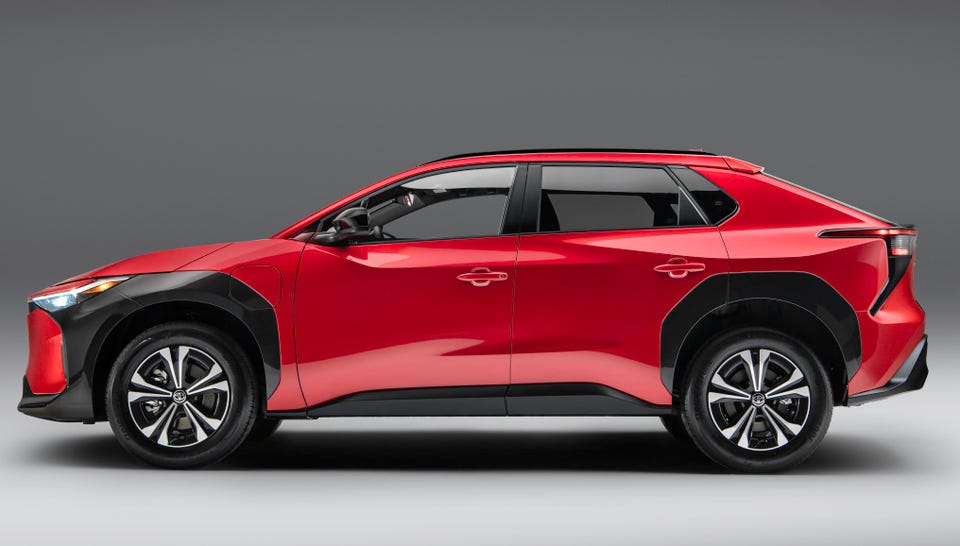Cars & Bikes Toyota Exec Says Lack Of Consumer Demand Makes U. S. Goal Of 50% Electric Vehicles By 2030 A Long Shot Jim Henry Contributor Opinions expressed by Forbes Contributors are their own.
I cover the pervasive, yet little-understood auto industry. New! Follow this author to stay notified about their latest stories. Got it! Aug 23, 2022, 03:09pm EDT | New! Click on the conversation bubble to join the conversation Got it! Share to Facebook Share to Twitter Share to Linkedin The Toyota bZ4X represents the first of a global series of Battery Electric Vehicles to be .
. . [+] introduced under the global “Toyota bZ” brand umbrella.
Photo: Toyota It’s unlikely mass adoption of Battery Electric Vehicles will develop as fast as environmentalists, the U. S. government , and most of the U.
S. auto industry seem to expect. That’s because, fundamentally, consumer demand just isn’t sufficient, says Jack Hollis, executive vice president of sales at Toyota Motor North America .
In turn, consumer demand isn’t sufficient because on average, BEVs cost too much, and because the infrastructure isn’t ready, like for recharging batteries away from home, Hollis said, in a recent webinar hosted by the Detroit-based Automotive Press Association . “I don’t think the market is ready. I don’t think the infrastructure is ready.
And even if you were ready to purchase one, and if you could afford it … they’re still too high,” Hollis says. According to Kelly Blue Book , sales of BEVs in the first half of 2022 were 370,726, including estimates for some brands, an increase of 75. 7% vs.
a year ago. That represents a market share of 5. 2% of new-vehicle sales in the first half, vs.
2. 5% a year ago. Roughly two-thirds, or 66.
1%, of BEV sales in the first half were Teslas. Meanwhile, it’s true that mass-market brands like Ford and Chevrolet are rolling out lots of BEVs in the next few years, but so far, most new BEVs are either luxury cars or big pickups and SUVS, priced in the luxury-vehicle range, Hollis says. MORE FOR YOU Computer Chip Shortage Could Drag Through 2022, Prolonging High Prices A 600-Mile Goodbye To The Beguiling Polestar 1 The Game-Changing Mid-Engined, Right Hand Drive Corvette Is Eating Into European Supercar Sales In Japan Hollis didn’t call out any competitors by name, but manufacturer’s suggested retail price for the 2022 Ford F-150 Lightning , for instance, starts at $39,947, not counting additional options, or destination charge.
That’s also before a possible tax credit of up to $7,500. That’s also, assuming you can get one. “Due to high demand, the current model year is no longer available for retail order,” according to ford.
com. The Biden administration last year announced a goal of 50% of U. S.
new-vehicle sales would be BEVs by 2030. Automakers have made non-binding statements endorsing a goal of 40% to 50% BEV share in that time frame. Without getting too specifically into the details, Hollis says that’s unlikely.
He cited the example of hybrids, which run on both a gasoline engine and an electric motor. Rounding up a bit, Hollis said it’s been not quite 25 years since Toyota introduced hybrids, most notably the Toyota Prius . Other brands offer hybrids, too.
But U. S. market share overall is still less than 10% for all hybrids, not just the Prius, he said.
That’s nowhere near 40% or 50% share, even though hybrids by now are familiar, affordable, don’t cause range anxiety, and don’t rely as heavily as BEVs on exotic raw materials, like lithium for batteries, from other countries with volatile foreign relations, Hollis said. “It took 25 years to get to less than 10% (market share) for hybrid — which is affordable, which is done with resources that are available,” he said. The “rhetoric” around electric vehicles is way out ahead of consumer demand, Hollis said.
“The consumer isn’t demanding it at that level. The consumer is not screaming, ‘30% or 40% by tomorrow,’ ” Hollis said. “And when you start pushing consumers into things they’re not ready for, some other consequence will occur.
” Jim Henry Editorial Standards Print Reprints & Permissions.
From: forbes
URL: https://www.forbes.com/sites/jimhenry/2022/08/23/toyota-exec-says-lack-of-consumer-demand-makes-us-goal-of-50-electric-vehicles-by-2030-a-long-shot/



